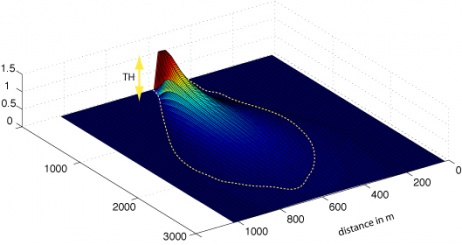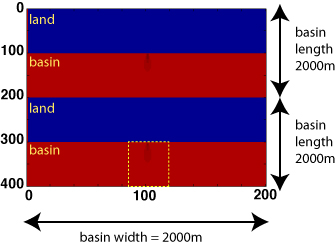Model:Plume: Difference between revisions
m (removed old questionnaire information. Replaced with form) |
m (fix piped link) |
||
| Line 79: | Line 79: | ||
Plume simulates hypopycnal plumes generated by a river draining its suspended sediment load into a receiving basin. | Plume simulates hypopycnal plumes generated by a river draining its suspended sediment load into a receiving basin. | ||
Satellite images of any river-delta emphasize the importance of river plumes. A plume’s behavior is dependent on the density contrast between the river water and the standing water (Albertson, 1950; Bates, 1953). Ocean water has a high density, and the plumes often flow buoyantly on the surface (hypopycnal). Another complementary model that deals with more rare hyperpycnal flows is [[Model:Sakura|Sakura]. The river’s sediment concentration adds density to the freshwater, but usually the effluent remains below the density of seawater. The shape that a hypopycnal plume will have, depends on a variety of factors: | Satellite images of any river-delta emphasize the importance of river plumes. A plume’s behavior is dependent on the density contrast between the river water and the standing water (Albertson, 1950; Bates, 1953). Ocean water has a high density, and the plumes often flow buoyantly on the surface (hypopycnal). Another complementary model that deals with more rare hyperpycnal flows is [[Model:Sakura|Sakura]]. The river’s sediment concentration adds density to the freshwater, but usually the effluent remains below the density of seawater. The shape that a hypopycnal plume will have, depends on a variety of factors: | ||
# Angle between the river course and the coastline | # Angle between the river course and the coastline | ||
| Line 97: | Line 97: | ||
[[ image:MC8bothGSD.jpg | 462 px ]] | [[ image:MC8bothGSD.jpg | 462 px ]] | ||
==References to plume theory== | ==References to plume theory== | ||
Revision as of 22:03, 19 April 2010
Contact
| Name | Eric Hutton |
| Type of contact | Model developer |
| Institute / Organization | CSDMS, INSTAAR, University of Colorado |
| Postal address 1 | 1560 30th street |
| Postal address 2 | |
| Town / City | Boulder |
| Postal code | 80305 |
| State | Colorado |
| Country | USA"USA" is not in the list (Afghanistan, Albania, Algeria, Andorra, Angola, Antigua and Barbuda, Argentina, Armenia, Australia, Austria, ...) of allowed values for the "Country" property. |
| Email address | huttone@colorado.edu |
| Phone | |
| Fax |
Plume
Metadata
Summary
Technical specs
In/Output
Process
Testing
Other
IntroductionPLUME [1] [2][3]Plume simulates hypopycnal plumes generated by a river draining its suspended sediment load into a receiving basin. Satellite images of any river-delta emphasize the importance of river plumes. A plume’s behavior is dependent on the density contrast between the river water and the standing water (Albertson, 1950; Bates, 1953). Ocean water has a high density, and the plumes often flow buoyantly on the surface (hypopycnal). Another complementary model that deals with more rare hyperpycnal flows is Sakura. The river’s sediment concentration adds density to the freshwater, but usually the effluent remains below the density of seawater. The shape that a hypopycnal plume will have, depends on a variety of factors:
The plume equations follow those of Albertson (1950) developed for a jet flowing into a steady receiving basin. Plumes of similar shape but differing concentrations result for each grain size in the model. Fine sand will generally settle rapidly, whereas clay can travel much larger distances. Naturally, this affects the geometry of the deposited sediments on the basin floor. River dimensions, i.e. the channel width, depth and velocity at the river mouth are input conditions. In addition, river sediment concentration and settling velocities for specific grain size classes are input parameters as well. Plume is a steady-state model, meaning that it simulates constant input conditions, representative of a 'unit' event. River dimensions for plume range over orders of magnitude, small streams of only a few meters wide have been run, as well as large continental scale rivers (for example the Ganges-Brahmaputra). Consequently, the spatial resolution of the grid is highly variable depending on the modeling objective. If plume is used in stand-alone mode, it runs events of a single day. If you are interested in exploring deposits of changing plumes over time you will need to use the PLUME model within the framework of the stratigraphic model Sedflux. References to plume theoryAlbertson, M.L., Dai, Y.B., Jensen, R.A., Hunter, R., 1950, Diffusion of submerged jets. American Society Civil Engineers Trans, v. 115, p. 639-697. Bates, C.C., 1953, Rational theory of delta formation. AAPG Bulletin, v. 37, p. 2119-2162.
Plume model papers
IssuesHelpHelp on Model OutputPLUME generates a comma separated (*.csv) file which shows sedimentation rates per specified grain size class in m/day for the entire model grid. Half of the model grid is land, the other half is the receiving marine or lake basin as shown in the accompanying figure. The sedimentation rate for the first specified grainsize is listed for every gridcell. The small plume in the example is visible in the middle of the grid. Then the grid repeats itself for the next grainsize, of which the plume has a different shape and sedimentation rate. So a grid of 2000m basin width and length, with gridcells of 10 by 10 m will have 400 rows by 200 columns, if the simulation was only run for two grain size classes. This would repeat on to match the total number of simulated grain size classes. Help on Simple Matlab Visualization of OutputIf you want to use PLUME output with Matlab you will have to cut off the header lines of the file in a text editor. These are just a couple of commands to get started with analyzing the output. In Matlab use the following commands: To import your generated output file: <geshi lang=matlab> > c=dlmread('*.csv'); </geshi> To create a planview map the plumes: > imagesc(c);
Usually the first grain size is the coarser fraction traveling in suspension, but it is dependent on your input file. If you just want to create a planview map of a single grainsize plume: > cg1=c(101:200,:);
> cg2=c(301:400,:);
> imagesc(cg1)
> figure
> imagesc(cg2)
If you want the plume area of all cells with more than a certain threshold of sediment deposited, in this example all area with more than 0.005m deposits, you can get the no-of-gridcells that contain layers thicker than a certain threshold: > n=sum(sum(cg1>0.0005);
> plume_area=n*10*10;
Similarly, if you want the plume volume of all cells with more than a certain threshold of sediment deposited, in this example all area with more than 0.005m deposits, you can get the no-of-gridcells that contain layers thicker than a certain threshold: > v=sum(cg1>0.0005);
> plume_volume=v*10*10;
It may be usefull to compare X-sections for the different grain size classes: > plot(cg1(25, :), 'r');
> hold
> plot(cg2(25,:));
Input FilesDownloadSimple Input Files for TestingA very simple scenario for the plume model has been posted here. It models a bankfull flood event for a small meandering river, draining into a lake. These files may be useful for testing whether the model is running.
Simple Output File for TestingThe associated output file, with grids of sedimentation rates per day, for both grain sizes can be found here:
Sourceplume is part of the sedflux model. Although it is also available as a seperate distribution, its source code is contained within the sedflux repository. To browse the repository, point your browser to: http://csdms.colorado.edu/viewvc/sedflux/?root=sedflux Command-Line AccessIf you plan to make changes, use this command to check out the code as yourself using HTTPS: # Project members authenticate over HTTPS to allow committing changes.
svn checkout https://csdms.colorado.edu/svn/sedflux/
When prompted, enter your CSDMS Subversion password. Non-members may only check out a read-only working copy of the project source. To obtain a CSDMS Subversion account or to become a member of this project, please email csdms@colorado.edu. GUI and IDE AccessThis project's Subversion repository may be accessed using many different client programs and plug-ins. See your client's documentation for more information. Subversion HelpFor help on how to use Subversion, an excellent manual is available online at http://svnbook.red-bean.com/ |



